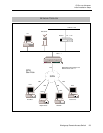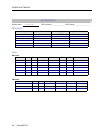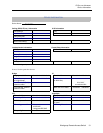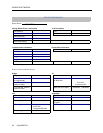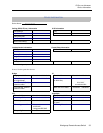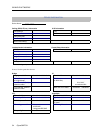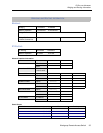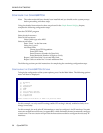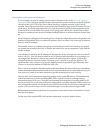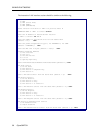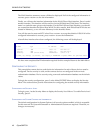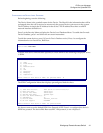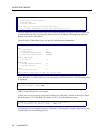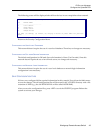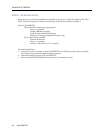
Workgroup Remote Access Switch 37
IP R
OUTING
N
ETWORK
Configure the CyberSWITCH
CONFIGURING THE IP INTERFACE INFORMATION
In our example, we need to configure three types of interfaces (refer to the Network Topology
Worksheet). The LAN type network interface represents the system connection to the IP Network
128.1.0.0 on the LAN. The WAN (Direct Host) interface is a logical extension of the LAN IP
network. Direct Host remote IP devices share the same IP address space as the IP network 128.1.0.0
on the LAN. The WAN network interface is a logical interface to an IP network connected to the
CyberSWITCH over the ISDN. The reason we are using both a WAN and a WAN (Direct Host)
Interface is to allow the two devices, Rick Bear and Ralph Moose, to call into somewhere else if need
be.
We will begin by adding the LAN interface. Press 2 at the IP configuration menu to begin the LAN
interface configuration. Press 1 to add an IP interface. Press 1 to select LAN as the type of interface
that you wish to configure.
The interface name is a symbolic name given to the interface. For the LAN interface, you should
use a name that describes the LAN. It could be the name of the site or department. Type SanFran
for this example.
You will then be asked for the IP Address for the interface. In our example, the value you should
enter is 128.1.1.1. You will then be asked for the IP Subnet mask information. In our example, we
are using a Class B address (without any subnetwork addressing) that requires 16 bits of the
address to define the network number. Therefore, press <return> to accept the default of “16”
significant bits. Press <return> to accept the default packet encapsulation type (Ethernet). Press
<return> to accept the default of 1500 as the MTU size.
Press <return> to accept the default transmit broadcast address. For almost all devices, this address
will let the broadcast be transmitted to all devices on the local network. For some older devices, you
may need to try some of the other selections to get the transmission to work correctly.
The rest of the LAN information requested pertains to the system RIP feature. (This information
will not be asked for if you have disabled RIP.) RIP is a protocol used to exchange routing
information among IP devices. Using RIP can automate the maintenance of routing tables on IP
devices and relieve you of having to keep the routing tables up to date manually. Static routes need
to be configured manually if we need to access a WAN network that is not directly connected to the
system, or if we need to access a LAN network through a router that does not support RIP.
RIP determines the shortest path between two points in a network in terms of the number of “hops”
between these points.
For the rest of the required RIP LAN interface information, accept the default values.



